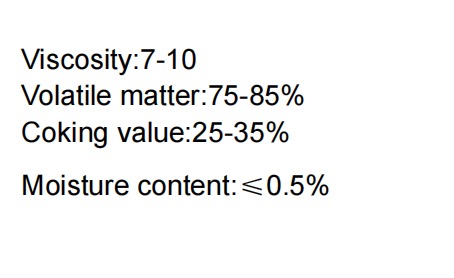Le goudron anhydre est un produit chimique. C'est un mélange complexe produit lors du traitement à sec du charbon à haute température. Il est principalement composé de composés aromatiques polycycliques, y compris des cycloalcanes, des alcanes et des composés phénoliques.
Le goudron anhydre est obtenu en éliminant l'eau du goudron de houille. C'est un sous - produit des entreprises de cokéfaction du charbon, qui est obtenu lorsque les installations de cokéfaction du charbon utilisent le procédé de distillation sèche pour produire du coke et du semi - coke.
Utilisation comme combustible : Le goudron anhydre a une valeur calorifique élevée et peut être utilisé comme combustible ou additif de combustible.
Applications dans l'industrie chimique : Le goudron anhydre est une matière première importante pour la production de nombreux produits industriels tels que les plastiques, les fibres synthétiques, les colorants, les caoutchoucs, les médicaments et les matériaux résistant à haute température.
Applications dans l'industrie des matériaux de construction : Il est utilisé pour fabriquer le béton bitumineux et les matériaux d'étanchéité pour toitures.
Applications dans l'industrie pharmaceutique : Le goudron peut être utilisé pour fabriquer certains produits chimiques et peintures. Après un traitement approfondi et un raffinage, il peut également être utilisé pour fabriquer des matériaux d'étanchéité de haute qualité, des matériaux isolants thermiques et des plastiques écologiques.
Le processus de fabrication du goudron anhydre comprend principalement des étapes telles que la distillation du goudron et le lavage - décomposition. Grâce à ces étapes, de nombreux produits chimiques peuvent être extraits du goudron. Plus précisément :
Distillation du goudron : Les différents composants du goudron sont séparés par distillation pour obtenir des fractions à différents points d'ébullition.
Lavage - décomposition : Le goudron est lavé avec une solution alcaline pour éliminer les impuretés et les composés phénoliques, afin d'améliorer la qualité du goudron.
Anhydrous tar is a chemical product, which is a complex mixture produced in the process of high-temperature dry distillation of coal, mainly composed of polycyclic aromatic compounds, including naphthenes, alkanes and phenols.
Anhydrous tar is obtained by removing the water in coal tar, which is a by-product of coal coking enterprises, and is obtained by the coal coking unit when the coal is produced from coke and semi-coke by a dry distillation process.
Anhydrous tar is used as a fuel: Anhydrous tar has a high calorific value and can be used as a fuel or fuel additive.
Application in chemical industry: anhydrous tar is an important raw material for the production of plastics, synthetic fibers, dyes, rubber, medicine, high-temperature resistant materials and other industrial products.
Application in the building materials industry: used in the manufacture of asphalt concrete, roof waterproofing materials, etc.
Applications in the pharmaceutical industry: Tar can be used in the manufacture of certain chemicals and paints, after advanced treatment and refining, it can also be used to make high-quality waterproofing materials, thermal insulation materials and environmentally friendly plastics.
The manufacturing process of anhydrous tar mainly includes steps such as tar distillation and washing decomposition, through which a variety of chemical products can be separated from tar. These include:
Tar distillation: The different components in the tar are separated by distillation to obtain fractions with different boiling points.
Washing and decomposition: Wash the tar with an alkaline solution to remove impurities and phenolic compounds in it and improve the quality of the tar.
The color is black and bright, and can be produced as per customer’s requirements. Daily output is 300 tons, with long-term stability.

